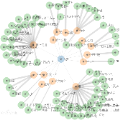In this paper, we study the problem of learning continuous vector representations of knowledge graphs for predicting missing links. We present a new approach called ConEx, which infers missing links by leveraging the composition of a 2D convolution with a Hermitian inner product of complex-valued embedding vectors. We evaluate ConEx against state-of-the-art approaches on the WN18RR, FB15K-237, KINSHIP and UMLS benchmark datasets. Our experimental results show that ConEx achieves a performance superior to that of state-of-the-art approaches such as RotatE, QuatE and TuckER on the link prediction task on all datasets while requiring at least 8 times fewer parameters. We ensure the reproducibility of our results by providing an open-source implementation which includes the training, evaluation scripts along with pre-trained models at https://github.com/conex-kge/ConEx.
翻译:在本文中,我们研究了学习知识图的连续矢量表达以预测缺失的链接的问题。我们提出了一个名为ConEx的新方法,该方法通过利用2D演进与具有复杂价值的嵌入矢量的Hermitian内产物的组合来推断缺失的链接。我们对照WN18RR、FB15K-237、KINISHIP和UMLS基准数据集的最新方法对ConEx进行评估。我们的实验结果显示,ConEx在所有数据集的链接预测任务上取得了优于RotatE、QuatE和TuckER等最新方法的绩效,同时至少需要8倍的参数。我们通过提供包括培训、评价脚本和在https://github.com/conex-kke/ConEx的预先培训模型在内的开放源实施方法,确保我们的成果能够再现。我们通过提供包括培训、评价脚本和在https://github.com/conex-kke/ConEx等经过训练的模型。



